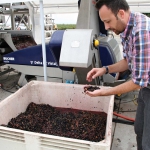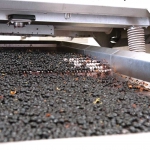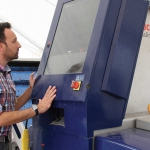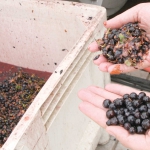New optical sorting technology allows grapes at Washington’s largest wine company to be sorted with meticulous detail, but at speeds needed for volume production.
Wine quality is strongly related to grape quality. Grapes are typically sorted at the receiving station by the winery to remove material other than grapes (MOG) that includes things like leaves, stems, and small or shot berries. MOG can add unwanted green bitterness or background noise to the finished wine.
Boutique wineries handling small lots of fruit during crush often use hand labor to sort out inferior grapes and unwanted material, says Juan Muñoz-Oca, head winemaker at Columbia Crest Winery. “But there’s a big difference in handling five tons of grapes over the course of harvest at a small winery and handling the 15,000 tons of grapes that we crush here,” he said.
Crush pads and cellars at Canoe Ridge Estate Winery and Columbia Crest were recently reconfigured with state-of-the-art destemming and sorting technology. Both wineries are owned by Washington’s biggest wine company Ste. Michelle Wine Estates and located near Paterson. The new equipment was installed to elevate wine quality and better create high-end, boutique-style wines. In addition, various fermentation vessels are being used by the two wineries to give complexity and more grape expression in their high-end wines.
Columbia Crest
At Columbia Crest’s white grape crush pad, a belt delivery system was added to the existing auger-screw conveyor system. This gives winemakers the option of using the belt conveyor to keep berries whole (with no skin contact) for wines like Pinot Gris or some maceration from the auger system for wines like Sauvignon Blanc as grapes move to the presses.
The red grape receiving station was updated as well. Key Technology of Walla Walla, Washington, developed a patent-pending MOG removal shaker. The system uses double-deck, stainless-steel vibrating tables that sort twice for MOG to better control the quality of must going to the fermentation tanks.
But Columbia Crest’s crown jewel is the new receiving area for red grapes destined for its reserve program.
The new reserve red station was operational for the 2014 harvest after extensive testing. Grapes first go through the French-made Pellenc Selectiv destemmer, which gently removes berries from stems to leave mostly whole berries. A conveyor belt paces fruit to ready it for the German-made Delta Vitalys, an optical sorting machine made by Bucher. Two cameras take multiple pictures of each grape; air jets blow the desired grapes to a conveyor belt for further processing while unwanted material like seeds, stem jacks, petioles, shot, green and sunburned berries, and insects drop to be conveyed and collected in a side bin.
“With this technology, you set the exact berry parameters—color, shape, size—that you want,” said Muñoz-Oca. “You can either pick out representative berries that you want and send a sample of 200-300 berries through the machine for the computer to calibrate or manually set the specs on the computer.”
A Pellenc centrifugal crush machine allows Muñoz-Oca to control the degree of crush before grapes are sent by gravity to fermenters in the cellar below.
Canoe Ridge
The new optical sorting technology in place for the 2014 harvest at Canoe Ridge Estate Winery is a result of a partnership between the winery and Key Technology, said Raymon McKee, winemaker at Canoe Ridge Estate. The winery tested a prototype optical sorter developed by Key Technology during the 2012 and 2013 harvest.
During the trial period, they used Key’s VitiSort optical sorter for about 50 days straight, running all of their fruit across it. “Early on, I could see it was a very robust machine. I couldn’t wait to install the finalized product,” McKee said.
The VitiSort machine is similar to the Bucher technology used at Columbia Crest. A high-speed camera takes 4,000 scans per second to inspect each grape, allowing perfect grapes to pass into a hopper for delivery to the fermentation tank and ejecting unwanted material with air jets. The machine can handle about five tons per hour.
Canoe Ridge also uses the vibrating, stainless steel sorting tables made by Key Technology. The tandem sorting tables, which handle around 80 tons of fruit per hour, were developed for Ste. Michelle Wine Estates after discussions between Key designers and McKee and Muñoz-Oca.
Muñoz-Oca said the resulting difference from the sorting technology is dramatic. “It has surpassed all of our expectations in reducing the noise or off-flavors in the wine. The amount of clarity that the sorting technology has brought to our wines is amazing,” he said. “The quality of winemaking is tremendously elevated with the technology.”
Blind tastings
In trials at both Columbia Crest and Canoe Ridge Estate, winemaking teams compared red wines made from the same lot of grapes handled with and without the sorting technology. The wines went through blind tastings ten months later. “The difference in the wines—made from the same block, same vintage, and same winemaking techniques—was incredible,” said Muñoz-Oca. “It was even more dramatic than we expected.”
He likens the sorting technology to brewing a cup of tea. “The tea bag contains the leaves and by steeping, you extract out the good stuff from the tea bag. The new technology allows me to extract out the good stuff (tannins and flavors) from the seeds and skins without getting background noise.”
McKee echoes the sentiment of his fellow winemaker.
“The result from the two machines—the sorting machine and optical sorter—is that you have almost perfect grapes going to the fermenters,” said McKee. “It’s phenomenal what happens when you work with basically perfect grapes. There’s no background noise, allowing you to draw out the most pure expression of the grape.”
Moving the needle
Although technology has mechanized most viticultural tasks, many winemakers still use Old World techniques. “The wine industry is late in coming to the high-tech party,” Muñoz-Oca said.
Optical sorting technology is making its way into wineries in Europe and a few high-end wineries in California, like Napa Valley’s Opus One. Columbia Crest is the first in Washington to use the Bucher machine on a large scale, according to Muñoz-Oca. Pepper Bridge Winery in Walla Walla is using optical sorting technology developed by Key Technology.
Muñoz-Oca believes that, in the near future, winemakers will sort not just by berry shape, color, and size, but also by berry density. He explained that density relates to sugars and the degree of ripeness.
“Already, at Ste. Michelle Wine Estates, we do differential harvesting based on canopy density measured by NDVI (normalized difference vegetation index) and use different gondolas for grapes from vigorous and less vigorous areas,” he said. “But I can see us diving deeper in the future by field-sorting grapes in different gondolas based on sugars and acids and not just canopy densities.”
McKee predicts that optical sorters will soon become the standard at high-end wineries. The technology is affordable for large wineries, he said, adding that machines range from $75,000 to $100,000, depending on the manufacturer. “Eventually, everyone will have one because it’s one of the best ways to improve wine quality. It moves the needle so far. Other commodities have been using optical sorters, and now it’s finally our turn.” •











Leave A Comment